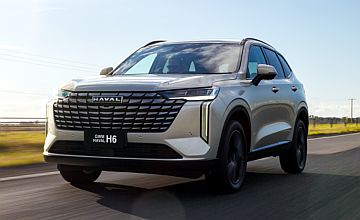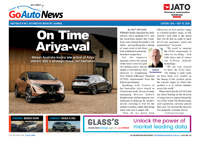Make / Model Search
OptionsCar reviews - GWM - Haval - H6GWM modelsOverviewWe like Very sharp pricing, better-appointed interior, cavernous rear seat, long warranty (including for fleets), high level of standard equipment, reasonable servicing costs, decent economy, more mature styling Room for improvement Tentative acceleration from junctions, generally rough hybrid system tuning, occasionally harsh ride, loose steering, urban fuel economy well above claim, cheap base model deleted Midsize GWM Haval H6 Hybrid good in parts29 Jul 2025 By TOM BAKER Overview
GREAT Wall Motor Limited—or GWM, as the Hebei, China-based car-making conglomerate markets itself in Australia and abroad—has come an awfully long way from the frankly fairly awful V240 ute of 2009.
Since then, GWM has gradually and carefully built out a respectable position in Australia. As the marque has pushed into Western markets with sophisticated tastes, the maturity of its products has grown—split into Haval, Cannon, Tank and Ora verticals locally.
A 2024 sales result of 42,782 deliveries was strong enough to make GWM Australia’s tenth-most popular car brand. The recruitment of experienced executives from rivals like Hyundai has led to a target of 50,000 sales this year and on to 75,000 in short order. A top-five position is the goal.
Getting there will require GWM’s key product lines to fire—but particularly its best-seller: the Haval H6 midsize SUV, which competes in Australia’s key passenger vehicle segment alongside the best-selling Toyota RAV4 (from $42,260 plus on-road costs)—and at least 22 other models.
Despite fiery rivalries among that set, the H6 has carved out a 5.8 per cent market share this year. The arrival of a facelift, accompanied by subtle pricing changes (reductions for some desirable grades) and new plug-in hybrids (PHEVs) is intended to increase the H6’s popularity.
First to arrive is the plugless hybrid version (HEV), while the PHEVs—for the first time in the conventional H6 shape—land in August, followed by the cheapest H6, packing a non-hybrid petrol (ICE), in September.
The H6 GT coupé-SUV continues in this mix while the boxy H7—essentially an H6 with a different ‘lid’ atop—also lands next month to pad out GWM’s midsize SUV mix, catering to slightly different customers.
While proportions are familiar, this year’s H6 facelift reduced, rather than added, to styling elements. Glitzy plastichrome has been banished for dark accents; a superfluous full-width light bar has been abandoned; and the front end’s wider grille looks more sophisticated.
Key dimensions are 4703mm in length, 1886mm in width, and 1730mm in height—while the wheelbase is 2738mm. The H6 is a bit larger than rivals like the RAV4; weight ranges dramatically from 1630kg (ICE) to 1980kg (PHEV with AWD).
Not all changes favour the consumer: the price-leading Premium base grade (previously $33,990 driveaway) has been deleted, leaving H6 Lux and Ultra as the remaining trims. Lux is an ICE/HEV proposition while Ultra can be had across all ICE/HEV/PHEV powertrains.
From $35,990 (d/a), Lux is well-specified packing bigger 19-inch black wheels, Comfort Tek artificial leather upholstery, six-way driver’s power adjustment, an eight-speaker stereo, 50-watt wireless charging pad, tilt/telescoping steering wheel and a 360-degree camera.
For 2025, the Lux also picks up a considerably enlarged 14.6-inch central touchscreen (to complement its 10.25-inch digital cluster), as well as a new bridge-type centre console dramatically increasing storage options.
Top-tier Ultra is $3000 dearer (from $38,990 d/a), adding desirable conveniences like heated/cooled front seats with driver’s memory and lumbar, heated steering wheel, an opening panoramic sunroof, privacy glass, head-up display, and an automated parking system.
Beyond no-cost Hamilton White, optional are three premium hues ($495) in Ayers Grey, Astral Pearl and Golden Black, while Ultra customers can replace black interior upholstery with cream for no extra outlay.
Increasing steps of electrification indicate key differences in running costs. The ICE powertrain claims 7.4L/100km (down 0.2L/100km), while the HEV is said to sip 5.2L/100km.
Meanwhile, the PHEVs have 106km (FWD) or 100km (a newer and more sophisticated AWD Hi4 system) electric range on the NEDC scale, and ‘dead battery’ consumption of around 5.0-5.3L/100km.
Warranty is seven years/unlimited kilometres for the vehicle (for both retail and fleet customers), while the battery packs of the hybrid versions are warranted for minimum 70 per cent state of charge for eight years/150,000km.
Driving impressions
Mechanically, the H6 HEV is similar to key hybrid-powered rivals like the Toyota RAV4, Hyundai Tucson and Kia Sportage. Suspension is MacPherson-type struts at the front end and multi-link independent at the rear. Tyres are respectable 225/55 R19 Hankooks all round.
Like those Korean SUVs, the Haval breaks away from the familiar Toyota by pairing a turbocharged petrol four-cylinder engine with its front electric motor and hybrid transmission. The turbo ICE (110kW/230Nm) promises greater refinement when the petrol is required.
It’s the 130kW/300Nm e-motor that is meant to do the heavy lifting, as the major contributor to the HEV’s 179kW/530Nm combined output claims. But the numbers fail to tell the entire story, as the H6 HEV experience is considerably less fluent than a drive in a RAV4 Hybrid.
Despite both the ICE and electric motor offering respectable performance, the H6’s hybrid control unit (HCU) often struggles to decipher which component should be awoken to handle the driver’s demands.
This includes pulling out of junctions, which can be an unedifying experience as the H6 lags and revs but offers no forward progress as the software asks itself repeatedly: ICE? Electric? Both?—with no answer immediately forthcoming.
Finally, a response is determined and the driver, who has demanded more power after going nowhere, is greeted by squealing tyres and jolting forward progress as bulk torque arrives.
The issue is that this problem is common but not entirely consistent, meaning it is difficult to drive around the quirk.
Thankfully, there are situations (such as merging and highway overtaking) where the HEV works in absolute harmony, giving drivers a glimpse into the brilliance of the system. If only that smooth tuning could extend to more driving situations.
Hopefully the two PHEV options do not offer up the same jerking accelerative experience in town. We do suspect the pure-ICE version is probably slicker in this regard, though it would be much thirstier.
We managed identical 6.0L/100km results on our highway and urban fuel economy tests with the HEV, meaning 1016km range from the 61-litre tank (which accepts 91 RON). Add in a cold start, though, and town fuel use balloons to 7.2L/100km—way above the 3.5L/100km urban claim.
Architecturally, the H6 remains atop the GWM B30 platform, internally codenamed the ‘Lemon’ platform. You can’t make these things up.
We hope this isn’t a case of nominative determinism, but Lemon does feel like it’s been squeezed at some point in the past, leaving the body with only middling rigidity and tightness in the corners.
The H6 is fine to drive but nothing more. Its electric power steering tune and steering ratio could both be more direct and engaging, and a strong tendency to understeer when cornering forces build above ‘average’ acts as a restraint on driver confidence.
Body control is fairly respectable and the spring rates feel close to correct, but the core ride quality of the H6 trends to harsh over expansion joints and potholes. The too-large alloys dent compliance, while bumps boom through the cabin quite noticeably.
The saviour of the Lemon platform could be Rob Trubiani, GWM’s recent chassis-celebrity hire—but his efforts have not yet borne fruit.
Melbourne-based Mr Trubiani made significant contributions to late-model Holdens (including the VE/VF Commodore) and has been appointed to oversee ride/handling improvements at the Chinese marque.
We’re told Mr Trubiani will be given significant leverage to alter the dynamic characteristics of GWM’s vehicles. We’re yet to test a prototype of the H6 (or any GWM) post-Trubiani touch, but having sampled his efforts at Holden, we think they will be worth waiting for.
Inside, the H6 looks and feels quite contemporary. Its extensive use of somewhat plush but artificial materials limits the outright feeling of expense, but at this price, that is hardly a compliant. Plus, the use of soft-touch materials has increased for 2025.
That includes across the intelligent new bridge-type console, which is coated in a slightly gummy material to stop phones and oddments sliding about. We hope it ages well.
While telescoping has been added to the steering wheel (thankfully), at issue is the fact the front seats still lack under-thigh angle adjustment, meaning long-legged drivers do not have adequate leg support. However, the heating/cooling functions work very well.
The H6’s infotainment interfaces have basic graphics and despite some unnecessarily arcane menu structures, can be tamed quickly; the wireless smartphone mirroring connection was without fault across our test, though the quality of the eight-speaker stereo was very mediocre.
The reasonably long wheelbase of the H6 allows for a cavernous rear seat experience, though, with exceptional legroom and shoulder room making it easy to transport five adults. The fitment of rear air vents as standard is appreciated in Australia.
Boot space measures 560 litres in five-seat mode across the range, and 1445L with the 60/40 split-fold rear seats lowered in the HEV/PHEV (1485L in the ICE version, which also benefits exclusively from a space-saver spare wheel and tyre).
At its $40,990 (d/a) price, the H6 Ultra HEV is enormously cheaper than high-specification versions of its hybrid rivals from outside China—and it’s also sharply competitive with its PRC-sourced peers.
You pay a price in a few rough edges—the tuning of the HEV system is a real bugbear. Still, with GWM’s ongoing attention to feedback, and the recruitment of at least one world-class engineer locally to correct the way its cars drive, we have hope the next update will be the one worth buying.  All car reviews Alfa Romeo Alfa Romeo Abarth Abarth Audi Audi Aston Martin Aston Martin BMW BMW Bentley Bentley Chrysler Chrysler Chevrolet Chevrolet Dodge Dodge Citroen Citroen Ferrari Ferrari DS DS Ford Ford Fiat Fiat FPV FPV Foton Foton Haval Haval Great Wall Great Wall Honda Honda Holden Holden Hyundai Hyundai HSV HSV Isuzu Isuzu Infiniti Infiniti Jaguar Jaguar Iveco Iveco Kia Kia Jeep Jeep Land Rover Land Rover Lamborghini Lamborghini Maserati Maserati Lexus Lexus McLaren McLaren Mazda Mazda Mercedes-Benz Mercedes-Benz Mitsubishi Mitsubishi Mini Mini Opel Opel Nissan Nissan Porsche Porsche Peugeot Peugeot Ram Ram Proton Proton Rolls-Royce Rolls-Royce Renault Renault Skoda Skoda Saab Saab SsangYong SsangYong Smart Smart Suzuki Suzuki Subaru Subaru Toyota Toyota Tesla Tesla Volvo Volvo |
OptionsClick to share
|









Facebook Twitter Instagram